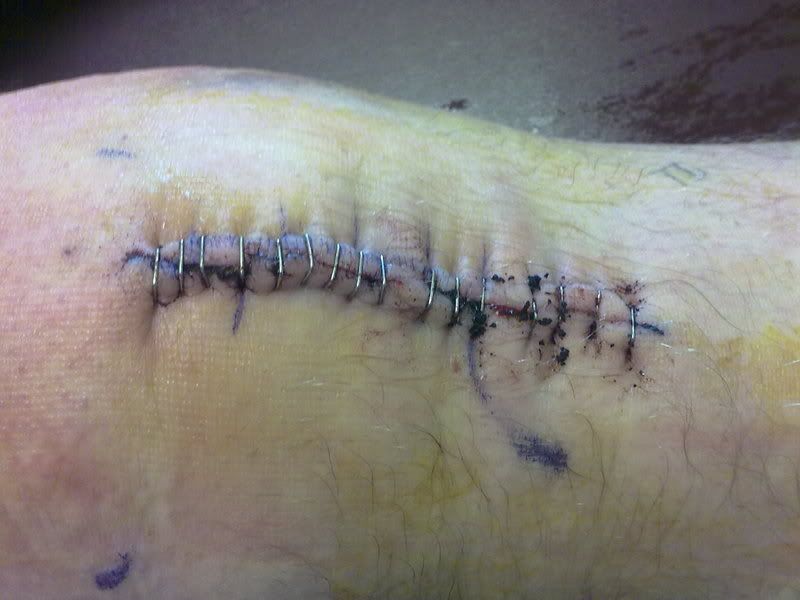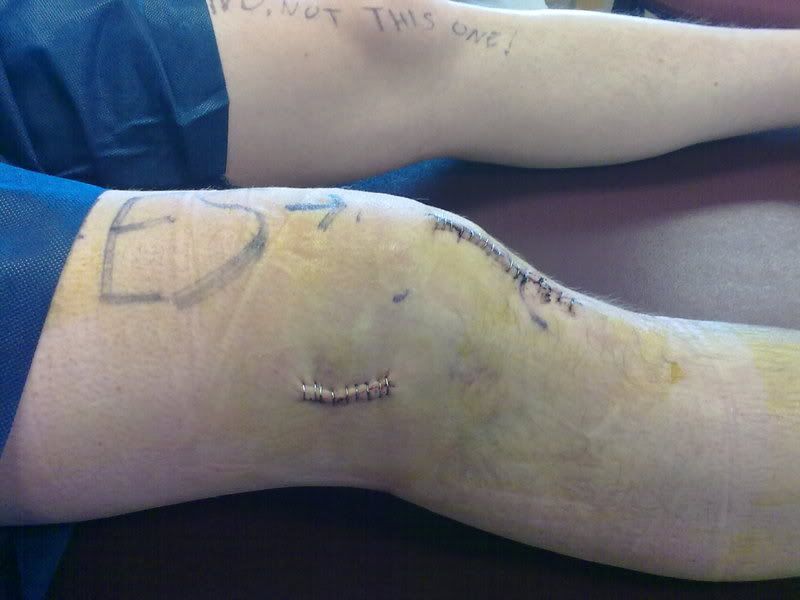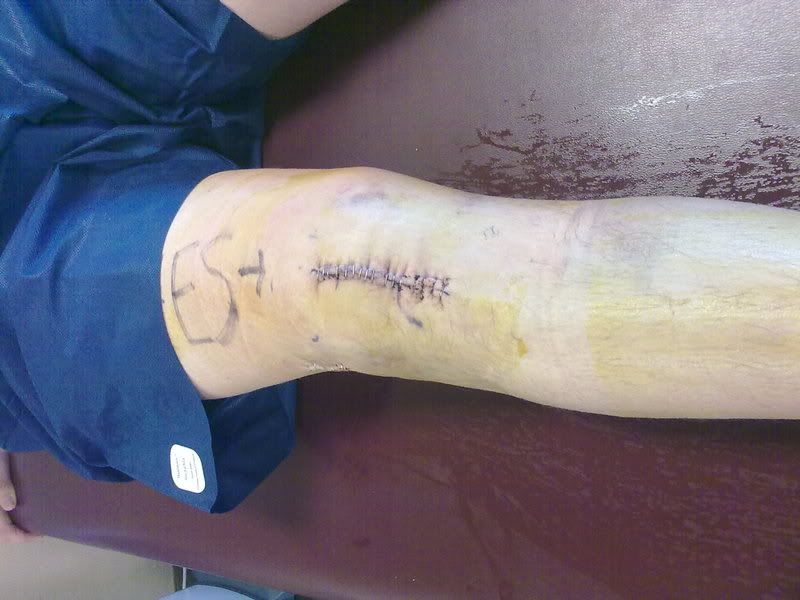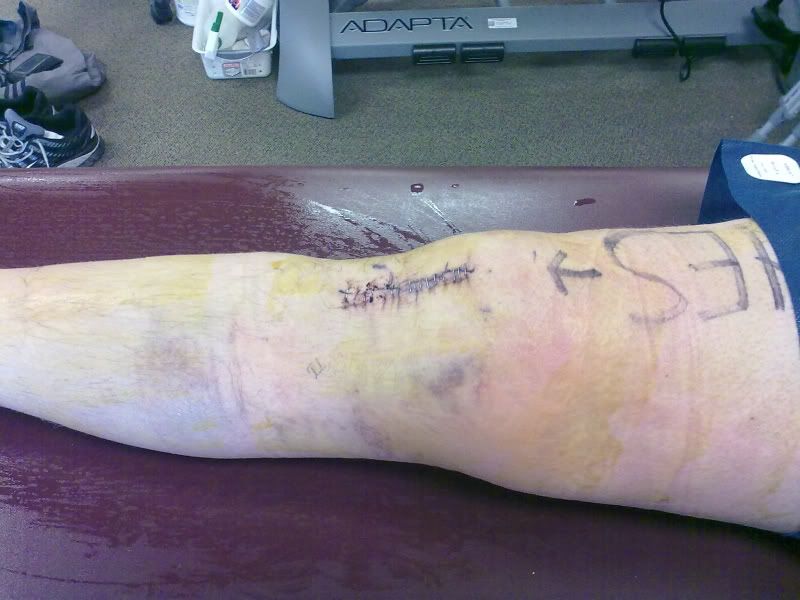I injured my right knee just before Christmas, playing basketball at the gym. I was just killing time while my wife finished up on the treadmill. Went to change direction, planted my foot, but my knee kept going. I felt a pop, then some searing pain, and I was on the ground. I suddenly realized, as the high school kids I was playing with stared down at me with clueless expressions, that I was the old fat guy writhing around on the gym floor! I ended up with a torn ACL, and tears in my lateral and medial menisci. I put off the surgery so I could go to Gulfport for my job, and to get my interview with Josh and Melissa done. There was no way in hell I was missing that trip!
Anyway, I finally had the surgery done this past Friday. They grafted a piece of my patellar tendon, with a bit of bone on each side, into the center of my knee to replace the ACL. Doing that required that they drill holes in my femur and tibia, to thread the graft into. Then it's fastened on each side with screws. The surgeon ended up trimming off a little bit of one of the menisci, but the other one had already started healing up pretty well.
Pictures of my knee, post-op, follow (Warning, kinda graphic!!).
Basically, I'm looking at 6 months of intensive rehab, so track season this year may not happen at all. I'm going to make every effort to recover as quickly as possible, but it just has to heal, and that takes time. The pain isn't terrible right now, surprisingly. A portion of my lower leg, from my knee to about halfway down my shin, is still numb to the touch. I assume the surgeon may have nicked a nerve during the operation. Hopefully, feeling will return in that region eventually, but for now, I'm perfectly content for it to be numb! I'm also on Percocet and Ketorolac, and just came off of Oxycontin on Tuesday. So yay for drugs, I guess, but I hate taking pills, so I'll be getting off of those as soon as possible. The Ketorolac will run out tomorrow. After that, I'll probably switch to Ibuprofen, if I still need an anti-inflammatory.
Therapy already started Monday. I'm doing a handful of muscle-activation and range of motion exercises for now, and a couple stretches, just at home. I go back in for another assisted session tomorrow, then have my post-op with the surgeon on Wednesday of next week. The staples should come out then, and my leg will look a bit less gnarly.
All of this simply continues the pattern of my on-track activities for the past few years. In 2008, I got married in May, which pushed my track season start back to August. In 2009, we bought a new house, which again delayed my start until August. This year, depending on how quickly my knee is rehabilitated and I get clearance from my doctors, my track season may be delayed until August or later.
This brings me to an interesting decision. Last year, I spent all of my track time trying to knock off the rust from the previous year, and saw precious little gains in terms of improving my riding. In fact, I saw no gains at all in terms of lap times. So once my knee is good enough to ride again, I will have to decide whether it is worth the time and expense to go to the track for a few weeks at the end of the season, or just to shelve it all for this year and come out swinging in 2011. The bike needs new tires, a new exhaust, and a few other tid bits before it hits the track again anyway, so I might be better served just waiting, doing those things over next winter, and getting the most out of it next year. But boy, is that ever depressing to contemplate.
Sheesh, 2011! I'll be hitting the track on a seven year old bike! I'll try to massage a few more ponies out of her, but chances are, I'll be increasingly outclassed. As much as I hate to think about it, eventually, I'm going to have to upgrade equipment. Still, I'm not particularly worried about that until I'm starting to race seriously. No sense in blowing money on equipment when the rider isn't up to it, right?
But anyway, there's plenty for me to do in the mean time. I'll be rehabbing the knee, then once that's good enough, getting back on the mountain bike. I was in the middle of a weight loss program (and having some success!) when I dorked up my knee, so I'll need to get back on track with that, as well. I'll do my best to keep this site up to date with my progress, and hopefully I'll have some more interview and article content to post as well!
Until next time...
~Cephas
THE FREE RADICAL
Be sure to head on over to R6Live.com and read my recent interview with Yamaha AMA pros Josh Hayes and Melissa Paris!
http://www.r6live.com/content.php?r=82-R6Live.com-Exclusive-Interview-Josh-Hayes-Melissa-Paris!
Also, don't miss OnTheThrottle's coverage of their recent back seat rides in two Ohio Air National Guard F-16s:
http://www.onthethrottle.com/content/view/554/1/
http://www.r6live.com/content.php?r=82-R6Live.com-Exclusive-Interview-Josh-Hayes-Melissa-Paris!
Also, don't miss OnTheThrottle's coverage of their recent back seat rides in two Ohio Air National Guard F-16s:
http://www.onthethrottle.com/content/view/554/1/
The road of automotive history is littered with the burned and twisted wreckage of men, vehicles, and companies. Often, they were brought to their untimely end not by the consumer or natural market forces, but by the power of corrupt government officials, auto manufacturing giants, and lobbyists.
Consider the story of Preston Tucker, an endlessly innovative American entrepreneur, engineer and automobile designer. After conceptualizing and designing for 15 years, he produced the 1948 Tucker Sedan, a vehicle so far ahead of its time that it threatened to turn the established auto industry on its head. The concept vehicle featured such innovations as a padded dash board, side impact and rollover protection for the cabin, driver-centric instruments and controls, a subframe-mounted engine assembly, fuel injection, disk brakes, seat belts, and most famously, a third headlight which would pivot to light a vehicle's course through turns.
All of these ideas were unheard of (for cars) at the time, but are commonplace today (with the exception of the turning headlight, which is available as an option on some high-end European cars). In fact, many of them are government-mandated. But in post-war America, the major automakers had not produced a noticeably new or different vehicle since the war started. They were in the business of selling the automobiles they wanted to build, not necessarily those that the consumer wanted to buy. So when Preston Tucker came along with a sedan that could singlehandedly decimate Detroit, they had to kill it.
At the unveiling of the first Tucker prototype, saboteurs cut into the rear suspension of the car with a hacksaw, causing it to break, rendering the car immobile. Negative press following the event colored public opinion against the new vehicle, despite its status as a prototype.
Tucker persisted, making radical changes to the vehicle's engine, transmission and suspension systems. The vehicle, now nearing production, was continuously improved to not only match, but far surpass anything coming out of Detroit at the time. Finally, the Big Three could wait no longer, and in a conspiracy involving Senator Homer Ferguson of Detroit, launched a mostly-contrived SEC investigation into Preston Tucker. The ensuing slanderous media frenzy and concurrent (and equally slanderous) government action proved to be too much for the fledgling automaker, and it folded, having produced only 51 complete vehicles.
Fast forward to January, 2010. The media coverage surrounding Toyota's recent wave of recalls is bested only by the aftermath of a catastrophic earthquake in Haiti, and the Saints going to their first Superbowl. A largely undiagnosed problem with the throttle systems on some Toyota models has, in a few cases, led to uncommanded acceleration, slow return to idle throttle, or other speed control issues. But if you peruse the media coverage regarding the situation, you would think that the entire Toyota fleet is careening wildly off the road, plunging their hapless drivers to their fiery deaths at the bottom of a ravine, like some poorly-scripted action movie.
Not surprisingly, it seems that even the number of crashes caused by the problem is in dispute:
First, the LA Times reports:
But the Associated Press, courtesy of The Advertiser says:
Since 1999, the actual number of reported complaints (not limited to crashes) related to "vehicle speed control" for Toyota vehicles to the NHTSA is 2,152. Divide that by the 2.3 million vehicles covered by the recall, and you get a failure rate of about .087%. The fatality rate works out to .00083%. This is far lower than the 1800 or so people who actually did die a fiery death in the 1973-87 GM pickup trucks fitted with ill-designed "side saddle" gas tanks. The fatality rate for this obvious, preventable design flaw was about .03%, or more than three times higher than the alleged problem with Toyota accelerators. GM's own study of the problem indicated a failure rate in accidents of a whopping 19%.
But while GM was forced to settle numerous individual and class-action lawsuits to the tune of hundreds of millions of dollars, a recall was never ordered. Former transportation Secretary Federico Pena was forced to stop the NHTSA's investigation, and the Justice Department brokered a deal for him to sign with GM that effectively precluded any further action against GM regarding the issue.
Interestingly, almost no mention whatsoever has been made of a popular GM vehicle, the Pontiac Vibe, also being affected by the same recall. The vibe was built in a joint venture with Toyota, but remains a GM vehicle, and is affected by the recall. But while information regarding the Vibe's recall is decidedly difficult to find, GM's special offers for Toyota or Lexus owners aren't. Perhaps understandably, the Big Three are working hard to take advantage of Toyota's problems. But this takes on a more sinister light given the following.
First, consider the person spearheading the investigation (and maliciously flubbing the public statements) about the recall: Former Illinois representative, and now transportation secretary Ray Lahood. Lahood is a liberal Republican product of the Illinois political machine, brought to his current post by virtue of his being good friends with Rahm Emmanuel. He has decidedly little experience in the realm of transportation, though he reportedly has significant financial ties to the industry he's supposed to be regulating.
House Transportation and Infrastructure Committee Chairman James Oberstar has basically said that the DOT's job is to be a yes-man to the White House, and that Lahood is a good candidate for the job (source: WSJ). In addition, he's in charge of regulating a vast amount of federal stimulus money, including having a hand in the bailout given to GM and other US auto manufacturers (except Ford). Interestingly, while Toyota's sales and stock price plunged precipitiously, based in no small part on Ray "The Other Joe Biden" Lahood's misstatement before Congress, the Big Three automakers are posting substantial gains.
Let's see how this all adds up. The government essentially owns GM and Chrysler now, which is great for the Democrats in control, because now they can capitalize even further on their unanimous labor union support. A foreign automaker, who routinely slaughters domestics in sales figures, has a statistically minuscule problem. The same government launches a barrage of investigations, negative press, and almost libelous comments against said automaker, causing their sales and stock to plunge.
Toyota, meet Tucker. Toyota certainly has the capital and savvy to withstand these disproportionate attacks, but the intentions of Toyota's assailants have not changed.
All of this is not to say that Toyota doesn't have a problem with the recalled vehicles. The problem, while statistically small, should be investigated and fixed, to ensure the safety of Toyota drivers worldwide. But the public should be wary of the conflicts of interest held by the government in this case, and what has swiftly become a witch hunt by the media.
~Cephas
THE FREE RADICAL
Consider the story of Preston Tucker, an endlessly innovative American entrepreneur, engineer and automobile designer. After conceptualizing and designing for 15 years, he produced the 1948 Tucker Sedan, a vehicle so far ahead of its time that it threatened to turn the established auto industry on its head. The concept vehicle featured such innovations as a padded dash board, side impact and rollover protection for the cabin, driver-centric instruments and controls, a subframe-mounted engine assembly, fuel injection, disk brakes, seat belts, and most famously, a third headlight which would pivot to light a vehicle's course through turns.
All of these ideas were unheard of (for cars) at the time, but are commonplace today (with the exception of the turning headlight, which is available as an option on some high-end European cars). In fact, many of them are government-mandated. But in post-war America, the major automakers had not produced a noticeably new or different vehicle since the war started. They were in the business of selling the automobiles they wanted to build, not necessarily those that the consumer wanted to buy. So when Preston Tucker came along with a sedan that could singlehandedly decimate Detroit, they had to kill it.
At the unveiling of the first Tucker prototype, saboteurs cut into the rear suspension of the car with a hacksaw, causing it to break, rendering the car immobile. Negative press following the event colored public opinion against the new vehicle, despite its status as a prototype.
Tucker persisted, making radical changes to the vehicle's engine, transmission and suspension systems. The vehicle, now nearing production, was continuously improved to not only match, but far surpass anything coming out of Detroit at the time. Finally, the Big Three could wait no longer, and in a conspiracy involving Senator Homer Ferguson of Detroit, launched a mostly-contrived SEC investigation into Preston Tucker. The ensuing slanderous media frenzy and concurrent (and equally slanderous) government action proved to be too much for the fledgling automaker, and it folded, having produced only 51 complete vehicles.
Fast forward to January, 2010. The media coverage surrounding Toyota's recent wave of recalls is bested only by the aftermath of a catastrophic earthquake in Haiti, and the Saints going to their first Superbowl. A largely undiagnosed problem with the throttle systems on some Toyota models has, in a few cases, led to uncommanded acceleration, slow return to idle throttle, or other speed control issues. But if you peruse the media coverage regarding the situation, you would think that the entire Toyota fleet is careening wildly off the road, plunging their hapless drivers to their fiery deaths at the bottom of a ravine, like some poorly-scripted action movie.
Not surprisingly, it seems that even the number of crashes caused by the problem is in dispute:
First, the LA Times reports:
Sudden-acceleration events in Toyota and Lexus vehicles have been blamed for at least 19 fatalities and 815 vehicle crashes since 1999.
But the Associated Press, courtesy of The Advertiser says:
A private firm said it had identified 275 crashes and 18 deaths because of sudden, uncontrollable acceleration in Toyotas since 1999.
Since 1999, the actual number of reported complaints (not limited to crashes) related to "vehicle speed control" for Toyota vehicles to the NHTSA is 2,152. Divide that by the 2.3 million vehicles covered by the recall, and you get a failure rate of about .087%. The fatality rate works out to .00083%. This is far lower than the 1800 or so people who actually did die a fiery death in the 1973-87 GM pickup trucks fitted with ill-designed "side saddle" gas tanks. The fatality rate for this obvious, preventable design flaw was about .03%, or more than three times higher than the alleged problem with Toyota accelerators. GM's own study of the problem indicated a failure rate in accidents of a whopping 19%.
But while GM was forced to settle numerous individual and class-action lawsuits to the tune of hundreds of millions of dollars, a recall was never ordered. Former transportation Secretary Federico Pena was forced to stop the NHTSA's investigation, and the Justice Department brokered a deal for him to sign with GM that effectively precluded any further action against GM regarding the issue.
Interestingly, almost no mention whatsoever has been made of a popular GM vehicle, the Pontiac Vibe, also being affected by the same recall. The vibe was built in a joint venture with Toyota, but remains a GM vehicle, and is affected by the recall. But while information regarding the Vibe's recall is decidedly difficult to find, GM's special offers for Toyota or Lexus owners aren't. Perhaps understandably, the Big Three are working hard to take advantage of Toyota's problems. But this takes on a more sinister light given the following.
First, consider the person spearheading the investigation (and maliciously flubbing the public statements) about the recall: Former Illinois representative, and now transportation secretary Ray Lahood. Lahood is a liberal Republican product of the Illinois political machine, brought to his current post by virtue of his being good friends with Rahm Emmanuel. He has decidedly little experience in the realm of transportation, though he reportedly has significant financial ties to the industry he's supposed to be regulating.
House Transportation and Infrastructure Committee Chairman James Oberstar has basically said that the DOT's job is to be a yes-man to the White House, and that Lahood is a good candidate for the job (source: WSJ). In addition, he's in charge of regulating a vast amount of federal stimulus money, including having a hand in the bailout given to GM and other US auto manufacturers (except Ford). Interestingly, while Toyota's sales and stock price plunged precipitiously, based in no small part on Ray "The Other Joe Biden" Lahood's misstatement before Congress, the Big Three automakers are posting substantial gains.
Let's see how this all adds up. The government essentially owns GM and Chrysler now, which is great for the Democrats in control, because now they can capitalize even further on their unanimous labor union support. A foreign automaker, who routinely slaughters domestics in sales figures, has a statistically minuscule problem. The same government launches a barrage of investigations, negative press, and almost libelous comments against said automaker, causing their sales and stock to plunge.
Toyota, meet Tucker. Toyota certainly has the capital and savvy to withstand these disproportionate attacks, but the intentions of Toyota's assailants have not changed.
All of this is not to say that Toyota doesn't have a problem with the recalled vehicles. The problem, while statistically small, should be investigated and fixed, to ensure the safety of Toyota drivers worldwide. But the public should be wary of the conflicts of interest held by the government in this case, and what has swiftly become a witch hunt by the media.
~Cephas
THE FREE RADICAL
Subscribe to:
Posts (Atom)









